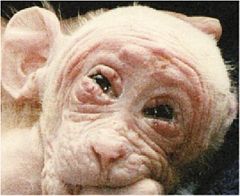University of California Riverside 1985 laboratory raid
 |
|
| Date | April 20, 1985 |
|---|---|
| Location | University of California, Riverside |
| Participants | Animal Liberation Front (ALF) |
| Property damage | $700,000, according to the university |
In 1985, a raid took place at a laboratory belonging to the University of California, Riverside (UCR) that resulted in the removal of a monkey by the Animal Liberation Front. This monkey, called Britches (born March 1985), was a stump-tailed macaque who was born into a breeding colony at UCR. He was removed from his mother at birth, had his eyelids sewn shut, and had an electronic sonar device attached to his head—a Trisensor Aid, an experimental version of a blind travel aid, the Sonicguide—as part of a three-year sensory-deprivation study involving 24 infant monkeys. The experiments were designed to study the behavioral and neural development of monkeys reared with a sensory substitution device.
Acting on a tip-off from a student, the ALF removed Britches from the laboratory on April 20, 1985, when he was five weeks old. The raid also saw the release of 467 mice, cats, opossums, pigeons, rabbits, and rats, and a reported $700,000-worth of damage to equipment. A spokesman for the university said that allegations of animal mistreatment were absolutely false, and that the raid caused long-term damage to its research projects.
The ALF handed the video of their raid over to People for the Ethical Treatment of Animals (PETA), which released it. The NIH conducted an eight-month investigation into the animal care program at the university and concluded it was an appropriate program, and that no corrective action was necessary.
Main articles
Animal testing
Alternatives to animal testing
Testing on: invertebrates
frogs · primates
rabbits · rodents
Animal testing regulations
History of animal testing
History of model organisms
IACUC
Laboratory animal sources
Pain and suffering in lab animals
Testing cosmetics on animals
Toxicology testing
Vivisection
...
Wikipedia

